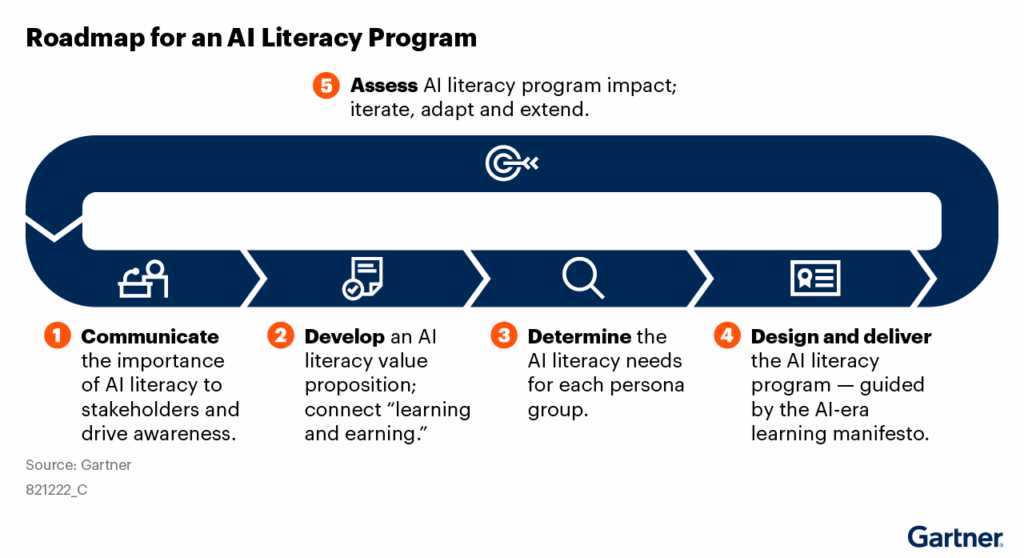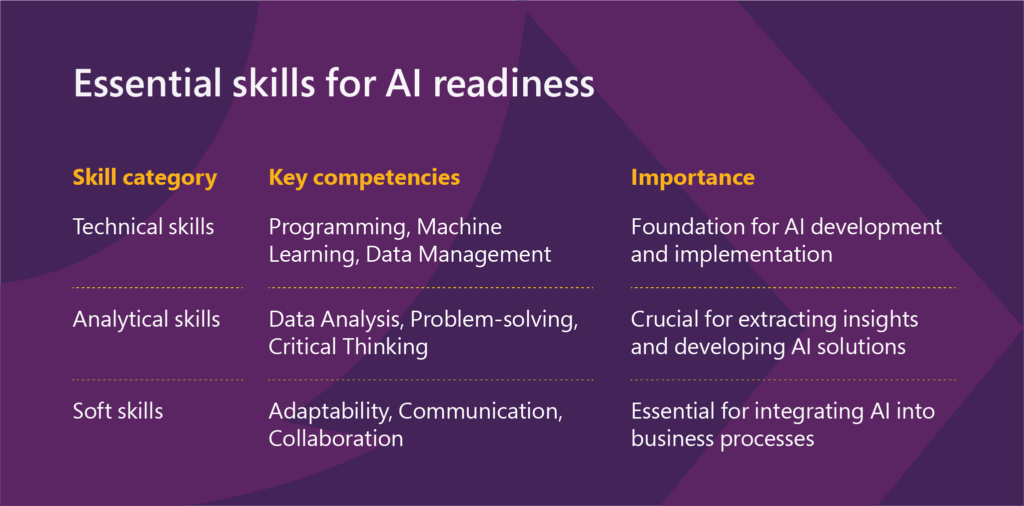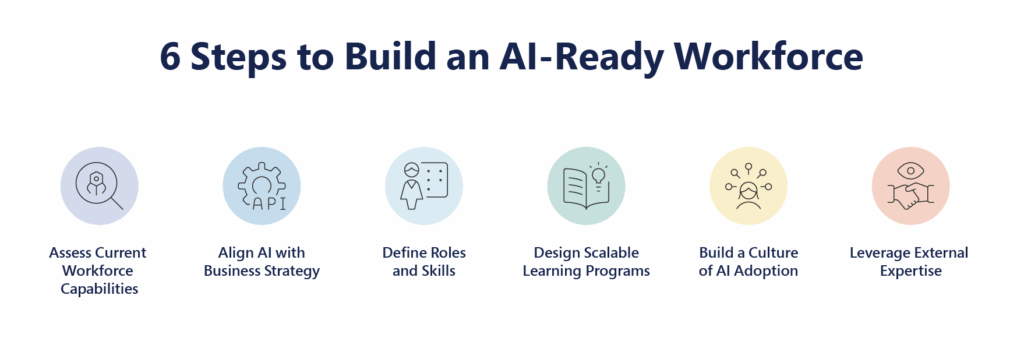Accelerate IT operations with AI-driven Automation
Automation in IT operations enable agility, resilience, and operational excellence, paving the way for organizations to adapt swiftly to changing environments, deliver superior services, and achieve sustainable success in today's dynamic digital landscape.
Driving Innovation with Next-gen Application Management
Next-generation application management fueled by AIOps is revolutionizing how organizations monitor performance, modernize applications, and manage the entire application lifecycle.
AI-powered Analytics: Transforming Data into Actionable Insights
AIOps and analytics foster a culture of continuous improvement by providing organizations with actionable intelligence to optimize workflows, enhance service quality, and align IT operations with business goals.
We’re living in a time where AI is not just knocking at the door but has entered the building, rewritten the rulebook, and is actively reshaping how we work, innovate, and compete. Yet, despite the rapid surge in AI adoption, there’s a striking paradox at play: while 77% of companies report they are either using or exploring AI technologies, only about 30% feel confident that their workforce is truly equipped to unlock AI’s full potential.
Here the real challenge isn’t the availability of AI-powered tools; but having the right people who are ready, skilled, and empowered to leverage them effectively for business benefits.
From virtual agents resolving banking queries to predictive analytics transforming supply chains, AI is everywhere. But none of it matters unless your people can keep pace. This is where the concept of an AI-ready workforce becomes mission-critical. It’s not about turning everyone into a data scientist—it’s about democratizing AI fluency, aligning people with purpose, and preparing them for roles that didn’t exist five years ago.
In this complete guide, you’ll discover:
- What makes a workforce truly AI-ready
- Why investing in talent – not just tools – pays off
- Practical, scalable steps to future-proof your organization
- Real-world success stories from industries like retail, banking, and healthcare
Let’s dive into the building blocks of tomorrow’s workforce today.

What Is an AI-Ready Workforce?
An AI-ready workforce is a group of employees equipped with the knowledge, skills, and mindset required to work effectively alongside AI tools and technologies. This doesn’t mean every employee needs to become a data scientist. Instead, it involves fostering a culture of continuous learning, adaptability, and digital literacy across the board.
An AI-ready workforce understands how to:
- Leverage AI to enhance their roles
- Collaborate with cross-functional teams on AI projects
- Navigate AI-driven workflows and tools
- Make ethical decisions about AI use
Building an AI-ready workforce also involves creating the right environment: leadership support, governance frameworks, and a learning infrastructure.
Why Building an AI-Ready Workforce Matters
1. Competitive Advantage
Companies that embrace AI are growing revenues and outpacing competitors. A McKinsey report found that AI leaders enjoy profit gains up to 20% higher than laggards. Those investing in AI talent are better positioned to adapt to new market trends.
2. Digital Transformation Readiness
According to BCG Research, 85% of digital transformation efforts fail- not because of flawed technology, but due to internal resistance and lack of necessary skills. A digitally literate workforce, especially one trained in AI competencies can significantly accelerate transformation efforts, reduce execution costs, and bring initiatives to market faster.
This insight aligns with Gartner’s recommendation that successful AI adoption begins with a structured AI literacy program. Gartner outlines a five-step roadmap that helps organizations build literacy through clear communication, persona-driven training design, and continuous assessment. CIOs are advised to lead these programs by aligning AI literacy initiatives with strategic goals, departmental needs, and employee growth plans.

Source: Gartner’s CIO’s Guide to Building an AI-Ready Workforce
3. Talent Retention and Growth
Forbes research says that 94% of employees would stay longer at a company that invests in their development. AI reskilling not only boosts job satisfaction and engagement—it also equips employees to navigate evolving job landscapes confidently.
By creating role-based upskilling pathways—something Gartner strongly emphasizes in its case studies—organizations can foster internal mobility, reduce attrition, and attract forward-thinking talent.
4. Business Resilience
AI frees employees from routine, manual tasks—shifting human energy toward creativity, strategic thinking, and relationship-building. In uncertain economic climates or during disruptive events, this adaptability becomes a vital asset. By embedding AI into daily workflows and evaluating its contribution to decision-making, teams are better prepared to handle operational volatility with confidence.
Key Skills for an AI-Ready Workforce
To prepare for an AI-powered world, your people need a balanced skill set that requires a mix of technical fluency, analytical, reasoning, and human-centered soft sills.

Technical Skills
At the core, your workforce needs to be fluent in the language of data and technology. This doesn’t mean everyone becomes a data scientist, but everyone should have:
- Data literacy and basic statistics to interpret trends and make informed decisions
- Familiarity with AI concepts (e.g., machine learning, NLP, computer vision)
- Experience with analytics and business intelligence tools
- Understanding of data governance, security, and compliance
Analytical Thinking
Data is only as valuable as the decisions it informs, Analytical thinking bridges the gap between raw insights and business actions. Key competencies here include:
- Problem-solving with data
- Pattern recognition and insight generation
- Hypothesis-driven decision-making
Human-Centered Soft Skills
Even the smartest algorithms need emotionally intelligent humans behind them. As AI becomes more embedded in workflows, soft skills take on new weight:
- Adaptability and growth mindset
- Empathy and collaboration in human-AI interactions
- Communication of AI insights to non-technical stakeholders
- Ethical awareness in AI usage
The Power of a Synergistic Skillset
Individually, these three skill areas are powerful. But when cultivated together, they create a workforce that is not only technically fluent, but also strategically sharp and ethically grounded. This synergy is what turns AI from a siloed tool into a cross-functional business driver.
When your employees can understand the tools, analyze the data, and communicate the impact, you unlock the full potential of AI—faster decisions, better outcomes, and a competitive edge that technology alone can’t deliver.
In addition, leadership needs to foster vision-setting, change management, and cross-functional governance capabilities to support organization-wide readiness.
Related Read: A leader’s guide to bridging AI skills gap
Step-by-Step Process to Build an AI-Ready Workforce
Building an AI-ready workforce requires a clear, strategic, and phased approach. Whether you’re just starting your AI journey or scaling existing initiatives, these actionable steps will help you lay a strong foundation, bridge skill gaps, and embed AI into the fabric of your organization. Let’s break it down.

Step 1: Assess Current Workforce Capabilities
Identify existing skill gaps through surveys, role mapping, and digital maturity assessments. Determine how different departments are impacted by AI.
Step 2: Align AI Strategy with Business Goals
Ensure AI initiatives support core business objectives. Use strategic guidance like AI Advisory for Business Success to align goals.
Step 3: Define Future Roles and Skill Sets
Create new job roles and redesign existing ones to blend domain expertise with AI understanding. Involve HR in building adaptive career frameworks.
Step 4: Design Scalable Learning Programs
Deploy a mix of e-learning, classroom training, mentorship, and certifications. Tailor content to different proficiency levels—from awareness to expert.
Step 5: Foster a Culture of AI Adoption
Empower teams to experiment. Establish innovation labs. Encourage cross-functional project teams to work with AI tools. Promote success stories.
Step 6: Leverage External Expertise
Partner with experienced vendors for advisory, training, and tooling. Explore how choosing an AI consulting firm can accelerate outcomes.
Common Challenges and How to Overcome Them
Transforming your workforce into an AI-ready powerhouse comes with its fair share of roadblocks. From cultural resistance to budget constraints, these challenges can stall even the most well-intentioned initiatives. However, with the right strategy, these hurdles can be turned into catalysts for growth and innovation.
Here’s how organizations can address the most common barriers:
1. Resistance to Change
Challenge: Many employees fear that AI will make their roles obsolete, while others struggle to see its relevance to their daily work. This resistance can slow adoption and create friction across teams.
Solution: Use storytelling and internal champions to build trust. Start with pilot programs that deliver fast wins.
2. Lack of Skilled Trainers
Challenge: Without experienced trainers who can bridge the gap between AI theory and practical application, learning programs can fall flat.
Solution: Collaborate with AI experts or firms like Quinnox. Encourage knowledge-sharing through internal communities of practice.
3. Misaligned Expectations
Challenge: Executives often expect instant ROI from AI initiatives, while employees may feel overwhelmed by unrealistic learning demands. Misalignment between expectations and outcomes can lead to disillusionment
Solution: Educate executives and managers on realistic timelines. Define clear KPIs for workforce readiness.
4. Siloed Efforts
Challenge: When departments operate in isolation, AI training efforts can become fragmented and inconsistent.
Solution: Create an AI governance structure. Assign cross-functional leads. Integrate AI goals into business unit roadmaps.
5. Budget Constraints
Challenge: While most leaders agree on the importance of AI readiness, budget limitations often stall progress.
Solution: Focus on high-impact, low-cost initiatives like foundational AI literacy. Seek co-investment from different departments.
Top 5 AI-Driven Trends in AI Workforce for 2025
As organizations race to integrate AI across functions, the way we prepare our people is evolving just as rapidly. Traditional training models are giving way to hyper-personalized, agile, and ethically grounded approaches that reflect the speed and complexity of modern AI adoption.
Here are five emerging trends reshaping how companies build an AI-ready workforce:
1. Rise of Internal AI Coaches
Enterprises are investing in internal AI coaches who guide teams on tools, ethics, and best practices—much like agile coaches.
2. Microlearning & Just-in-Time Training
Bite-sized, role-relevant content delivered through digital channels is becoming the preferred way to keep pace with fast-moving AI innovations.
3. Generative AI & No-Code Tools
Tools like ChatGPT and other LLMs are democratizing AI. Training now needs to include prompt engineering and responsible usage of generative AI.

4. Inclusion in AI
Bias mitigation and inclusive design are becoming essential. Upskilling must include modules on ethical design and algorithmic fairness.
5. AI-First Organizations
A growing number of businesses are adopting “AI-first” mindsets, where AI is considered at the strategy table—not just the execution layer.
How Quinnox Can Help You Build an AI-Ready Workforce
A cornerstone of Quinnox’s AI strategy is the Quinnox AI Guild, a passionate internal initiative dedicated to building AI fluency across the organization. The AI Guild operates as both a learning platform and an innovation catalyst, empowering employees to develop, apply, and scale AI solutions across domains.
What is the Quinnox AI Guild?
The Guild is a structured community of AI enthusiasts and practitioners across Quinnox, committed to driving an “AI-first” mindset within the organization. It is guided by three strategic outcomes:
- Foundational Uplift: Equip 100% of front-line and client-facing teams with Gen AI literacy, enabling better customer conversations and positioning Quinnox as a thought leader.
- AI Innovation: Enable sandbox experimentation and hands-on development of AI solutions, leading to reusable assets and demonstrable IP.
- AI at Work: Infuse AI into daily functions across delivery, sales, and bid management teams—transforming internal operations and client engagements alike.
Operating Model and Learning Tracks
The Guild follows a tiered learning journey, helping individuals advance through five key growth stages: Initiate, AI Apprentice, Code Warrior, Contributor, Forge Master, and AI Maverick. These levels signify increasing expertise and contribution to Quinnox’s AI journey.
In addition to structured training, the Guild supports:
- Regular hackathons and events for idea incubation
- AI champions across BUs and geographies
- A sandbox environment to safely experiment and learn
- Recognition and rewards for contributions to AI projects
Strategic Business Value
The Guild bridges the gap between AI capabilities and real-world business needs. By fostering a culture of innovation and collaboration, it helps Quinnox accelerate delivery of:
- AI-infused solutions tailored to client challenges
- Custom tools and IPs with measurable business impact
- Enhanced employee engagement through career advancement in AI
Through initiatives like the AI Guild, Quinnox becomes not just AI-enabled—but AI-empowered, delivering accelerated business outcomes for clients and a dynamic, future-ready environment for its people.
At Quinnox, we go beyond technology—we empower people. Our comprehensive AI and Data Services are designed to enable organizations at every stage of AI maturity.
Here’s what we offer:
- AI Maturity Assessment: Baseline your readiness across people, process, and tech
- Customized Learning Journeys: Role-based upskilling for business leaders, IT, and operations
- Business-Driven AI Use Cases: Leverage AI Agent Use Cases to train teams using real scenarios
- Change Management Frameworks: Support cultural adoption through communications, workshops, and incentives
- AI Governance Models: Build transparency and accountability in AI operations
Explore our full suite of AI and Data Services to see how we integrate learning, innovation, and delivery into one seamless AI transformation roadmap.
Real-World Applications and Success Stories
Example 1: Retail
We helped a global retailer roll out a recommendation engine. Through targeted training, marketing and analytics teams learned to interpret and act on AI-driven insights. Sales from recommended products increased by 18%.
Example 2: Banking
Quinnox worked with a leading bank to deploy AI-powered chatbots. By upskilling customer service teams, we ensured a smooth transition. The bank saw a 30% reduction in first-level support calls.
Example 3: Healthcare
A U.S. healthcare provider initiated a conversation after discovering our blog on AI-driven data integration. This led to a consulting engagement focused on enabling clinicians and admins to adopt predictive tools for patient care.
Conclusion
In a world where AI is no longer a futuristic ambition but a present-day differentiator, building an AI-ready workforce is a strategic necessity. Technology may set the pace, but it’s your people who determine how far and fast you go.
At the heart of every successful AI transformation is a workforce empowered with the right mindset, tools, and support. And that’s where Quinnox AI (QAI) Studio plays a pivotal role. QAI Studio is a living, breathing ecosystem where learning, experimentation, and innovation converge. From real-world AI use cases to immersive hands-on experiences, it enables organizations to bridge the gap between theory and tangible business value. Backed by the Quinnox AI Guild—we help businesses not just upskill but activate their workforce to co-create AI-powered solutions with confidence and speed.
Unlock the full potential of your people with Quinnox and lead the AI-powered transformation from the front.
FAQs Related to AI-Ready Workforce
An AI-ready workforce is equipped with the skills, tools, and mindset to work effectively with AI technologies. This includes technical know-how, data literacy, and adaptability.
Because technology alone doesn’t drive transformation—people do. Empowering employees with AI skills ensures innovation, productivity, and business continuity.
Key skills include data literacy, AI awareness, problem-solving, adaptability, collaboration, and ethical thinking around AI.
The steps include assessing current capabilities, aligning with business goals, designing training programs, fostering a culture of AI adoption, and engaging external experts like Quinnox.
